Back To Blogs / Blogs / Mar 2021
An Irrawaddy Voyage
By Paul Strachan, Pandaw Founder
By the 1920s, travel to Burma became all the rage. To give an idea of the destination's popularity, over a hundred books were published about Burma travels lapped up by the armchair travelling public. There were lavishly illustrated books describing journeys through river valley and coasts; books about plant gathering in the mountains, from which came so many of our garden rhododendrons and azaleas; books about sporting in Burma, with its big game hunting that was said to rival Africa; there was even a book about mahseer fishing on the upper Irrawaddy. Burma came late to the empire and with its magical atmosphere and pristine ancient culture, it called out to those seeking the mystical east, with great unexplored tracts of country and of course great rivers that offered an enchanting monotony.
After disembarking from a Bibby Liner or a Paddy Henderson steamer at the Rangoon docks along the Strand Road after a three-week voyage out, the traveller would transfer to one of the great Rangoon hotels, many of which were owned by the Armenian Sarkies family. The Strand survives, tragically 'restored' so badly that little of the original architecturally or atmospherically, remains. Other options were the Minto Mansions, British India or Orient hotels. There was a Thomas Cook office on Phayre Street, close to the IFC office, and here mail or telegrams could be received, traveller's cheques cashed, and onward travel arrangements made. Any trip to Burma would include a voyage on an Irrawaddy Flotilla Company steamer. Some chose to go all the way to Mandalay from Rangoon on a great line steamer which took eight days in the 1920s, while othersbooked a Rangoon to Mandalay cargo steamer as these were the slow boats which provided more time ashore in the many fascinating ports of call. Some would take the train to Prome and join the ship there, cutting the journey down to five days. Those wishing to go to Bhamo might take the train to Mandalay or even up Katha and jump on one of the weekly smaller shallow draft steamers that plied this route. Whichever route was chosen no one 'did' Burma without a cruise on a flotilla steamer, which was a real highlight.
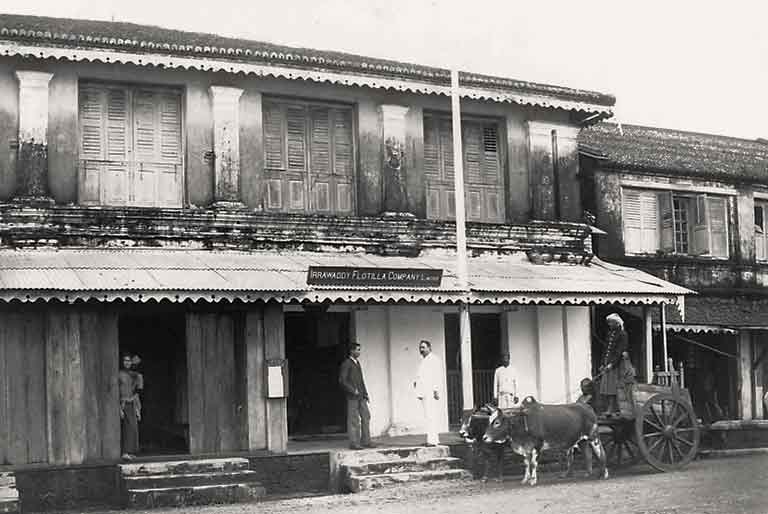
IF Agency
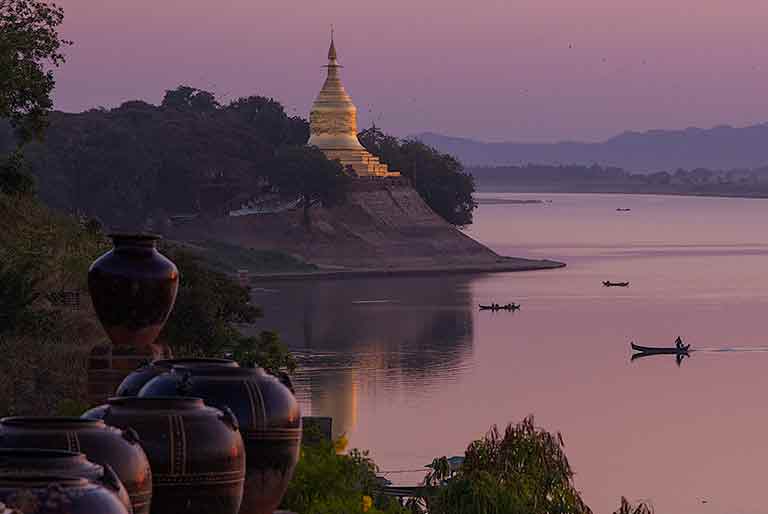
View of the Irrawaddy River
Major Raven-Hart made the trip in the Java in 1939 on his way up to Bhamo to paddle back down in his famous Canoe Errant that flew the red ensign and travelled with him to various continents to canoe their great rivers. Raven-Hart remarked that "the food was good, and very Scottish with Dundee marmalade and Crawford's biscuits and porridge daily and most of the officers were Scottish". Raven-Hart loved his voyage, sailing all the way from Rangoon to Bhamo by IFC steamer with a change of ship at Mandalay. Between the first-class section upper deck forward and the second class on the upper deck aft sat the deck passengers on their woven mats with their baggage and goods piled around them, puffing on their cheroots, playing cards or chess as children ran riot and monks sat mediating. Raven-Hart happily kicked off his flip flops to take up invitations to join groups on their mats, share cheroots, chew beetle and play chess. Old India hands could not believe how open and friendly the atmosphere was and so unlike India as here in Burma a Westerner could be accepted and join in so easily. Raven-Hart would spend more time on deck getting to know the Burmese than up front with the Europeans with their "drab clothes and drab faces and raucous voices and yelling laughter".
At first, I thought I must have aboard a Burmese equivalent of a Sunday school picnic: everyone was in silks and fine linen, and everyone seemed to know everyone, and to like everyone, and children wandered from one family circle sitting on one cane mat to another party sitting on each other, each entirely 'at home', boxes and pillow marking off and comfortably furnishing each temporary abode.
?Likewise, for many a traveller an Irrawaddy voyage was not just a voyage through a country but a revelation of Burmese life and character. Everyone agreed that there was no better way to understand Burma and the Burmese than by going on a steamer voyage and this continued until very recently. Much of my travelling up and down the country in the 1980s was by 'line ship' where I made countless friends and really got to know the country, regrettably then without the benefit of the full Scottish breakfast. Colonial officers and their families proceeding to the hill station of Maymyo would prefer to take the week-long voyage to the overnight sleeper train, simply because it was so much fun. Stopping off every day to explore often charming little port towns or sitting on deck with a good book, this was the ultimate in relaxation. The author William Somerset Maugham, who travelled by steamer to Mandalay in 1929, summed it up with "river travelling is monotonous and soothing".
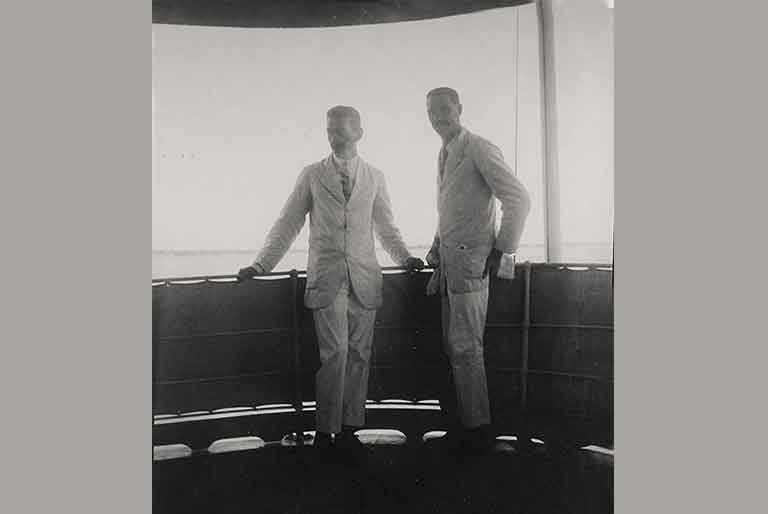
Scenes on deck, 1930s
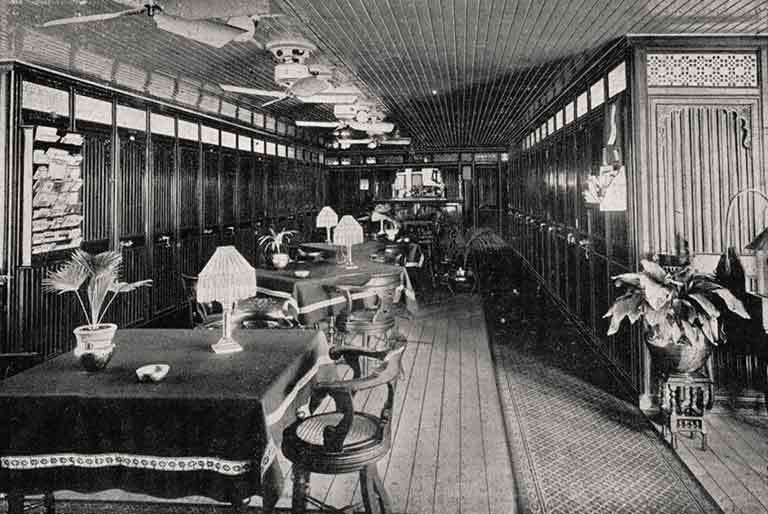
Saloon of Rangoon-Mandalay Express Steamer
First class accommodation on company ships was of a high standard. As said, this was in the forward part of the upper deck and the cabins ranged round a saloon. Doors were louvered to allow air to pass and on the line steamers there were electric fans in the cabins. Air would blow down through the saloon from an opening at the front that led to the captain's deck with its steering position. Scotsman Richard Curle, publisher and friend of Joseph Conrad, describes being couped up on board:
The happy-party atmosphere draws all together, the honeymoon couple, the tired engineer from Rangoon, the American oil driller, the man like a Cambridge don who is arranging the census and discusses music, the major on a tour of inspection, the young officers of the ship with their realistic talk and sentimental love of banjo melodies, the robust missionary who looks at you as if he knew something about you not at all to your credit, the fever-stricken youths down on leave from the jungle.
No you can't escape your companions on an Irrawaddy steamer, construction of all of which, whether large or small, seem to be exactly the same. The first-class accommodation is shut off entirely from the vessel; it consists of one long saloon, with cabins opening out to either side and a table down the centre, a saloon which bulges at the end, where cabins cease, into a sort of drawing room with easy chairs. Then through sliding doors you come to the bow of the ship, the observation post from which the expanse of the river opens before you. A cramped life, you will admit, in which one might be excused for sleeping too much.
Curle, like Raven-Hart would escape this stuffy colonial atmosphere in the passenger decks:
...were it not for the comfort of the IFC steamers and the varied life that is about you on the third class deck and on the towed flats, one would miss nothing by the experience. But that life is Burma in little. The Burmese love to travel on the river. They compose themselves in huddled rows till the whole large deck resembles a tropical bean-feast. They squat down contentedly with their bundles and their merchandise, with their food and their cooking stoves, in a fantastic medley of gay colours. They talk, they sleep, and the subdued hush of that drowsy life passes over the ship sweltering down the Irrawaddy beneath her awnings. The smell of the tethered cattle in the flats, going to the delta for the rice harvest, mingles with the smell of curries and fruits, and chickens and dogs pick their way amidst the recumbent passengers.
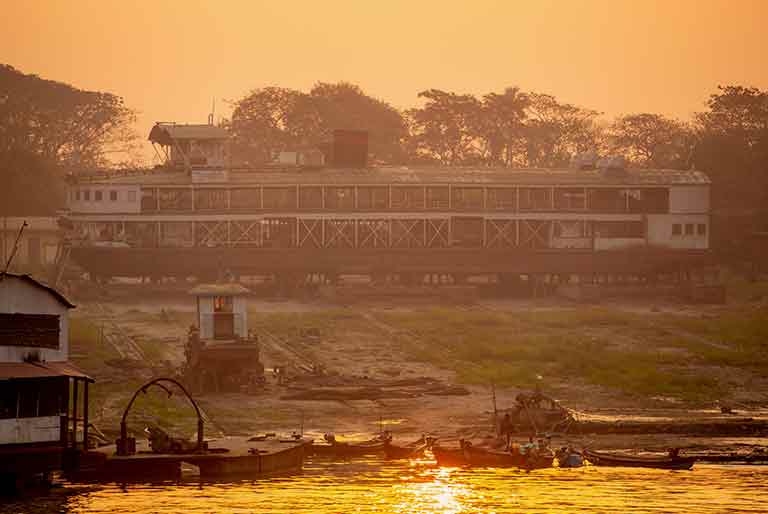
Old Irrawaddy Ship
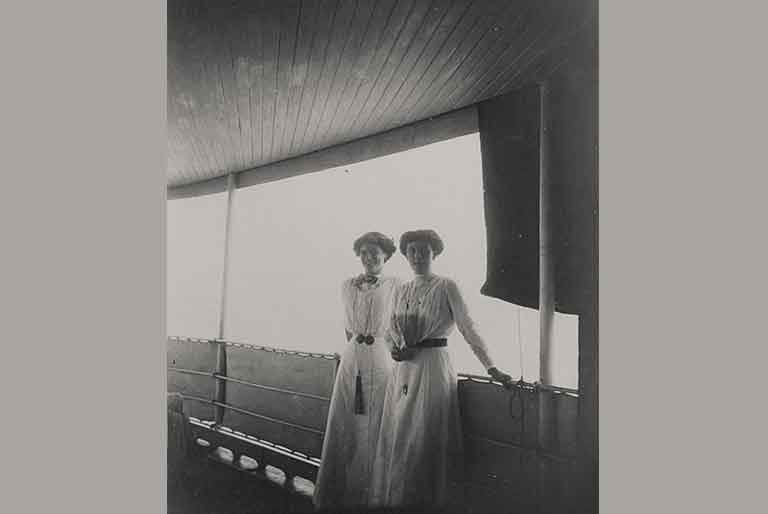
Scenes on deck, 1930s 2
IFC ships did not have wheelhouses until the flying bridge was added to P class ships in the 1930s, where it remains to this day. Instead, the commander was able to move around an open foredeck and look up and down river without being closed in. Having the first-class travellers observing from the saloon and constantly popping out to ask questions must have been a mixed blessing. Some captains and their first officers were full of local information and colour and others somewhat more taciturn. There was a second steering position on the main deck below which was mainly used at night as the searchlight was situated on the upper deck and it was necessary to get below it to see well. Though quite small, the cabins were comfortable and well fitted out in teak and brass and one photo shows an 'IF' monogrammed carpet. In the central saloon, gargantuan meals were served by a Madrassi butler and Burmese mealtimes were followed with an early light snack, followed by the 'full Scottish' at about 11:00 which is when most Burmese have their main meal. Then there would be afternoon tea and a late supper accompanied by copious amounts of beer. I have a small collection of IFC tableware salvaged from ships sunk in the war and a mint condition water jug that Alister McCrae gave me, all of the best quality and emblazoned with the company logo.
After supper a dram or two would be poured and the ships officers, all recruited from sea-going backgrounds, would sing shanties accompanied no doubt by their banjos. Curle was perhaps being a little superior in his treatment of his fellow passengers - it might be that quite a jolly time was had as the ships moored up on a remote bank in the cool of the night. Captains of ships moored nearby would pop over for a game of cards and join in the sing song. Up-country colonials, bored stiff in their riverside bungalows and desperate for news and companionship, would wander on board to join the fun for an evening.
The second-class section was situated in the aft section of the upper deck. Whilst up front was strictly for the European businessmen, 'heaven born' civil servants, army officers and well-healed tourists, the second class-section would be where Indian money lenders, Chinese pawn brokers, Armenian bankers and German-Jewish merchants would be found. Thus, on any steamer you had a microcosm of colonial Burma's political, economic and social hierarchy. The European administrators and representatives of global business lounging serene with their chota pegs on steamer chairs in front, the Indian and Chinese money makers wheeling and dealing at the back and the Burman squatting on his mat squeezed in the middle chatting away and puffing on his cheroot.
As Walter B Harris was to comment of his Irrawaddy voyage in East for Pleasure (1929): "It would be ungracious to omit that the comfort of the traveller is studied in every way and that every consideration is shown to him". Indeed, the flotilla along with Thomas Cook in Rangoon were responsible for opening up Burma to tourism as the Edwardian romantic travel writer of the 1900s gave way to the American 'globe trotter' of the 1920s for whom a voyage to Bhamo was a must. Actually, the first American tourist was probably Ulysses Grant, recently retired as president who visited Rangoon in 1877 as part of a retirement world tour. (In the 1904 a future American president, Herbert Hoover who was a mining engineer reopened the silver mines at Namtuprompting Maurice Collis' remark "he ran off with the silver".) The majority of American travellers were neither past nor future presidents, but rather prosperous adventurers in those care-free times in the decade preceding the Wall Street crash. It became the role of the officers of the flotilla to entertain them with 'river tales' and the agents of the company in the port towns along the way to dispense tourist information and make arrangements for them. As many of the agents were themselves retired senior captains, they became tourist attractions in themselves, spinning yarns of life under the old kings and the fall of Mandalay.
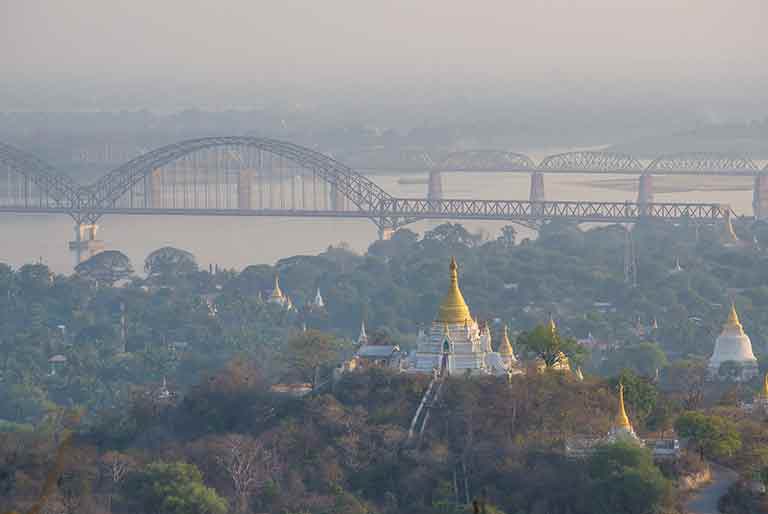
Burma Sagaing hill
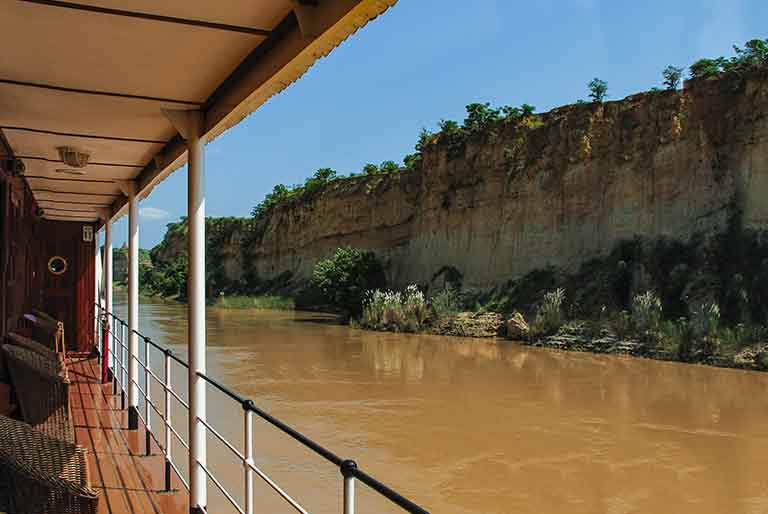
1st defile Upper Irrawaddy
Sportsmen came to Burma in great numbers and it was often said that for big game, Burma rivalled Africa. There were wild animals everywhere. Tigers pestered villages which as per traditional layout were encircled with thick thorny hedges and stockade like fences with gates that would be bolted closed at night to keep these great beasts out. Owners of orchards in the Mandalay suburbs complained of wild elephants trampling their crops at night. Everywhere jungle fowl abounded. Maurice Collis would, after closing his Sagaing courthouse each day, wander off into the bush and bring back a bag of game. Flotilla officers would shoot duck on the riverbanks. Famous sportsmen came out, like John Hanning Speke, of Nile fame, who visited Lower Burma in the 1850s whilst serving in India. The best book on the subject was by Colonel Pollock and WS Thom and offers practical information on all aspects of hunting big cats like the tiger, leopard and panther as well as buffalo, rhinoceros, gaur, gayal, tsine and several types of deer, hogs, wild dogs, jackals and of course elephants. Upon seeing an elephant grazing in a field in 1894, one flotilla captain took up his rifle and shot it dead, later discovering it belonged to the Forest Department and was fined £60 and lost his gun licence. Tamed working elephants, with a working lifespan of at least fifty years, were worth a tidy sum and thereafter the shooting of animals from moving steamers was banned. The keen sportsman could jump on a Bibby liner out to Rangoon and then on up the Irrawaddy on an IFC steamer and bag anything from a tiger to an elephant over a winter season. Today it is unlikely that you will see any of these animals running wild but that may be as much due to the pressures of a population that has grown eight-fold as the depredations of the white hunter.
The flotilla, privately owned, had a quasi-official status and took on many of the functions of government organisations whether sorting and delivering mail, river conservancy to ensure the free flow of transportation for all users of the river, and providing ships in time of war. In addition to this, the company carried an assortment of royalty and important personages. Dalhousie, Curzon and most successive Viceroys made a Burma tour and of course travelled on the Irrawaddy amidst great fanfare and pomp. Ships would be repainted white and the funnels yellow for these voyages, being the official government colours. The first 'royals' to travel on a flotilla ship were poor King Thibaw and his family who had just been deposed and was being taken away to exile in provincial India. Prince Albert Victor, the Duke of Clarence, was packed off on an imperial tour in 1889 following a hushed up gay scandal, and it was even rumoured that he was Jack the Ripper. He travelled on the Beeloo or ogre and his last act before leaving Burma was the opening of the Rangoon Sewage Works – who says the colonial administration lacked humour!
The future George V and Queen Mary, as Prince and Princess of Wales, travelled on the Japan in 1906 and can be seen relaxing on deck in this photograph. It was said that the prince was fond of Oxtail soup and the commander, the well-known Captain de la Taste, instructed the butler to buy half a dozen. Later he found half a dozen oxen tethered in a pen on the lower deck.
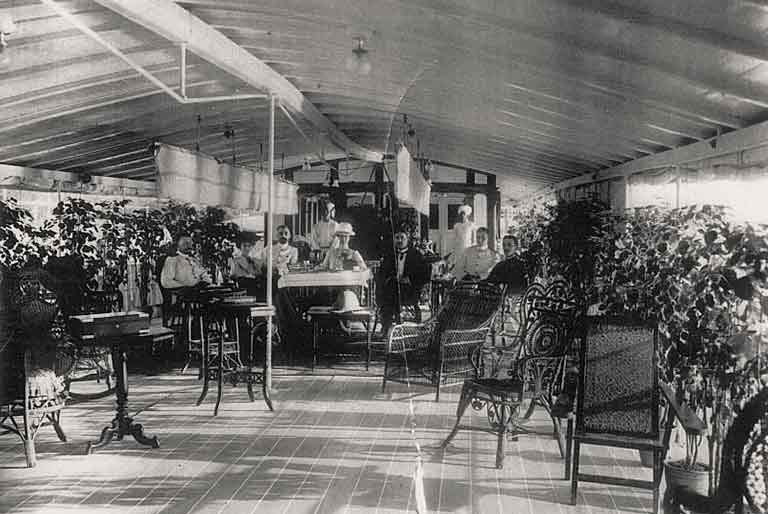
Prince and Princess of Wales on the Japan, 1906
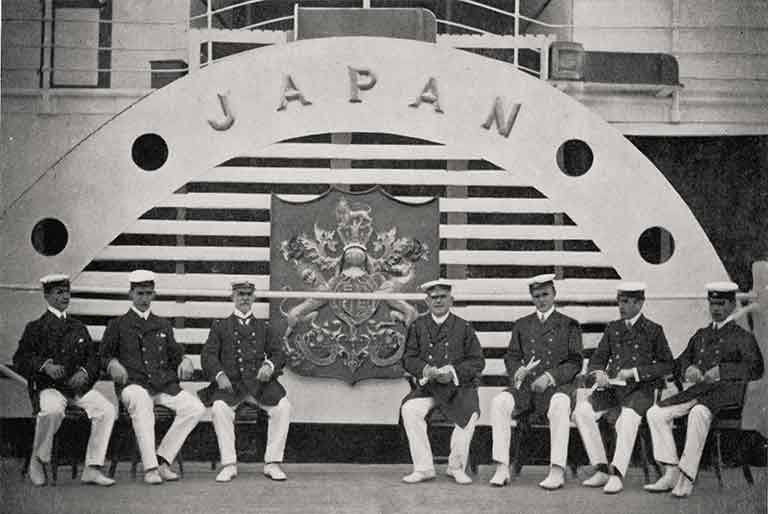
Officers of the Japan at the time of the Prince of Siam's visit, 1906
These royal cruises were splendid affairs with much pageantry as the ship called at ports along the way where triumphal arches of welcome would be specially erected and military bands, guards of honour and local dignitaries of all races lined up for presentation. Think of Captain de la Taste at the summit of his career commanding the most splendid of all the company's ships, commodore of the greatest privately-owned flotilla in the world, with royal guests on board whose safe carriage was his sole responsibility.
The Crown Prince of Siam travelled appropriately on the Siam in 1906 and Lord Mountbatten made his first visit to Burma in 1921 in the company of the then Prince of Wales, who as Edward VIII was later to abdicate in favour of Mrs Simpson. Alister McCrae, then a young manager with the IFC, was one of the party on the Nepaul and was presented by the Prince with a silver cigarette case as a thank you for taking care of no doubt very smooth arrangements. On that cruise, flying boats belonging to the recently formed Irrawaddy Flotilla Airways met the ship along the way to delivery despatches and mail. Going ashore, sycophantic banners read "Tell Daddy We are Happy Under British Rule" whilst the police kept independence agitators well away from the royal entourage. On returning to Rangoon the Prince reviewed a regatta on the Royal Lakes from Scandal Point. Mountbatten's last of many Irrawaddy cruises was on the Mingyi (Denny, 1947) during the sixties when he visited as a guest of General Ne Win who kept the Mingyi as his private river yacht, and for that reason she retained her steam boiler and side paddles when all the other ships of the fleet were converted to diesel and outboard propeller propulsion in the 1970s.
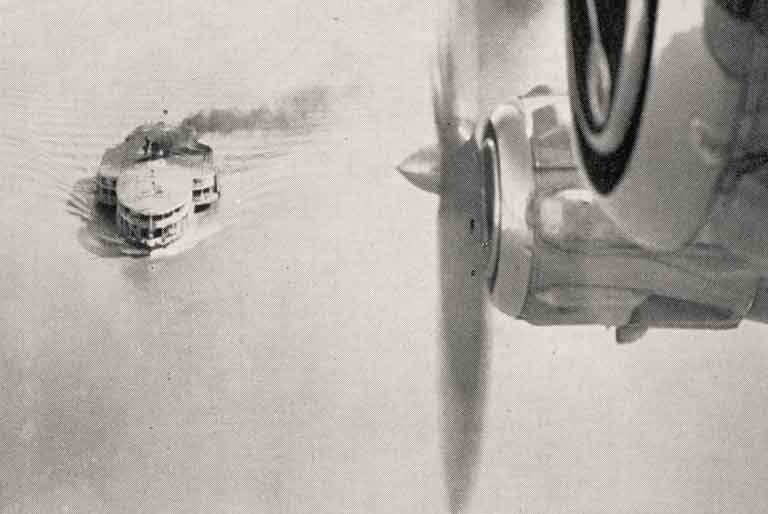
Delivering the Prince of Wales's mail
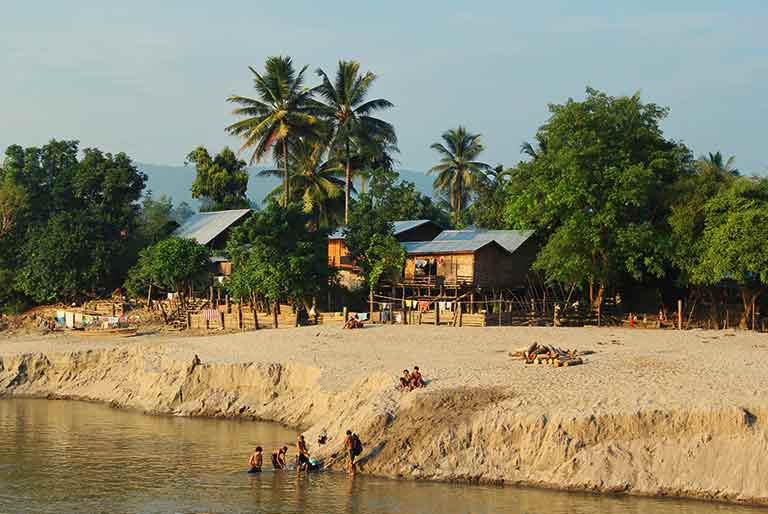
Katha 1st defile Upper Irrawaddy
But what of the five million or so Burmese passengers who travelled up and down river in a year? As has been noted the Burmese adored river trips, it was very much in their character to waft down a great river in a party atmosphere. As Norman Lewis noted in the 1950s, often people going to see friends off would impulsively decide to come along too. I have seen when an upbound steamer meets a down steamer and they heave-to for exchange of provisions and information that people would spot friends and jump over the rails to join them and go back the way they came. Here were a people who for millennia had never strayed far beyond their village boundaries taking trips to the sacred city of Mandalay that they had only ever dreamed off. When I travelled down the Chindwin in the 1980s, if I asked anyone why they were going to Mandalay they would say 'hpaya-pu' or pilgrimage as they sat on great bundles of contraband.
The spiritual and material could happily co-exist on these journeys. Back in the 1880s, the river opened the country up to possibilities not just of pilgrimage and trade, but of ideas. As colleges and universities opened,bright village boys could travel to distant cities to be educated and learn about the world beyond Burma. For the hermit kingdom, as Burma had been, the opening of the rivers was surely the single most important factor in the opening of the country.
And all aspects of Burmese life could be found on these decks – groups of toga-clad hpongyis who always seemed to be travelling around visiting other monks in distant monasteries; prisoners shackled together with their police escorts, who were generally to be found fast asleep and often had to be woken up by their charges when the ship arrived at their destination; Burmese ladies in their Sunday best before a tiny mirror,forever working away at their toilette with hair combing and thanaka rubbing; the 'a-smokin of a whackin' white cheroot' that was communal and passed around even to children and babies with a tin underneath to catch the sparks. There would be the colourful, exotic sight of travelling circuses and pwe or theatre groups ever on the move to various festivals. As each river town had a pagoda festival, there was a terrific movement of people up and down river visiting each other's festivals. Annually there was a massive migration of peasants together with their bullocks from upper Burma to work the Delta rice harvest. Lawyers in black taipon jackets together with their ever-hopeful clients would be making their way to provincial capitals on the 'ferry services' that were timed around court opening hours in a country that had happily embraced the British legal system to the point where litigation became something of a speculative hobby for many.
Alister McCrae and Alan Prentice in their book on the flotilla describe first-hand experience in checking tickets when they would make a surprise boarding from an inspection launch:
Obtaining tickets for the check was not always easy. For this operation passengers could be divided into different groups. First there were those who did not know where they had put their tickets and could not find them. Next there were those who thought they knew where they had put their tickets, but still could not find them. Then there was the distrustful citizen who kept his ticket in some secret place which required a long search for recovery. There were also those who had temporarily moved down to the lower deck for social or toilet purposes and had left their ticket on the upper deck. Finally, there were those who had actually lost their tickets through misadventure of having them blow overboard.
Elderly passengers often wore jackets with many pockets both inside and outside the garment, all of which had to be searched before a ticket would be recovered. Matchboxes were for some reason considered to be safe places to keep tickets, but frequently in river breezes both matches and tickets were blown overboard when tickets were presented. It was common to find groups of passengers who kept family tickets in tiffin carriers (food containers), sometimes immersed in the wet contents for added safety, but illegible and sticky when handled. Dainty Burmese women with pocketless eingyi (muslin jackets) often kept their tickets skewered to their tight under-bodices by a safety pin that gave an added security if the pin was rusty. But at least they knew where their tickets were.
The birth of babies on board was a common occurrence giving rise to much joking over whether it had a ticket or not. It was said to bring good luck to the ship, and was therefore encouraged with the offer of rewards. Soon they found they were effectively running floating maternity homes they had to withdraw the offer. Our Pandaw IV had at least three babies born on it when acting as a floating hospital during the Cyclone Nargis in 2008, but it brought the ship little luck and when it went to India, it was stolen by our dodgy Indian business partner.
Whilst chickens and dogs roamed the upper deck, the lower deck and flats might contain pens of cattle, horses and sometimes elephants. The transport of elephants was a profitable income stream for the company as the timber firms moved working elephants from area to area. This was never easy as it was extremely difficult to coax an elephant averaging eight foot high and three tons in weight on board. In 1884 there was the case of six elephants to be carried across the mile-wide river at Prome. Having managed to get them onto a flat and across the river, the steamer returned to the other side and sounded its horn. The elephants thinking this was a mating call dived into the river and swam back across.
On one occasion an elephant that fell through the wooden deck into the hold below and the only way to get it out was to employ villagers to fill the hold up with sand. On other occasions they created tunnels of bamboo fonds and leafy branches to disguise the flat and induce them to go on board. I have seen elephants standing on deck whizzing down the river and its quite a sight. In 1908 the company developed a special elephant flat with extra thick teak planks (steel decks being too hot for them) and piped water was supplied to keep them cool. These flats were towed on the port side avoiding the noisy engine drains on the starboard side,as it was essential to avoid anything that might disturb them and cause a stampede.
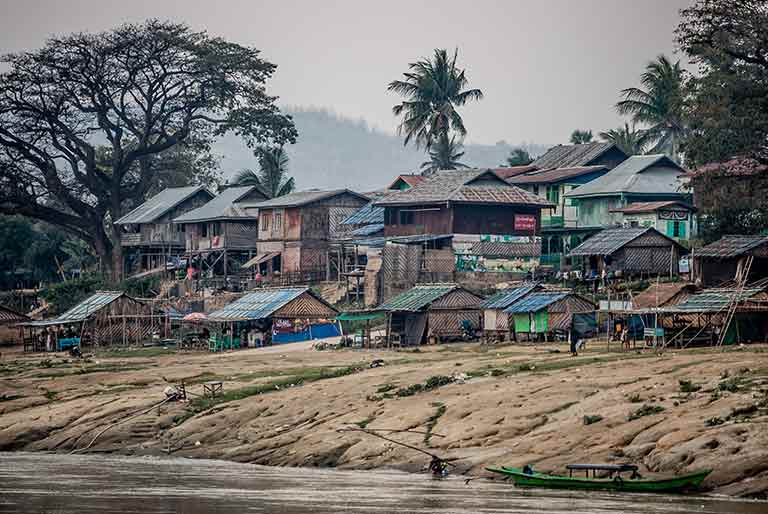
Village along the Irrawaddy
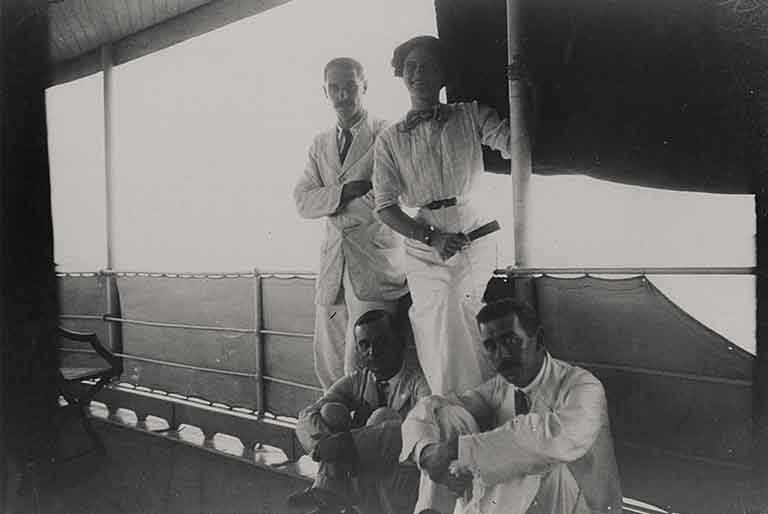
Scenes on deck, 1930s
Nearly all early 20th century travel writers embarked on a voyage to Bhamo enthused about the fortnightly zay-thinbo or bazaar boat, slower than the express steamer but far more fun. In essence, this was a huge mobile floating market with steamer and flats filled with market stalls selling all manner of produce. These stalls were prized possessions and handed down from generation to generation and would have long standing business connections in the villages. Scott O'Conner explains:
Thus if the headman Moung Bah, of Moda village, wishes for a new putsoe (sarong) of fashionable dog tooth patter, or his wife a tamein (lady's sarong) of the new apple green and pink tartan, or Ma Hla the village belle, a necklace of Birmingham pearls, they go down to the steamer landing and with much detail describe their requirements to Ah Tun the Chinaman, or Sheik Ibrahim, the Mohammedan trader, and in the fulness of time, the 'fire boat' trumpeting its advent, brings to each of them his heart's desire.
The great excitement of a voyage to Bhamo was the fact that you were sailing upriver on what was effectively a floating market full of bustle and excitement in port and then serenely indolent between ports. O'Conner captures the market at rest between stops: "seated on gay carpets, reclining on soft quilts, slumbering under silken tartans, flirting, gossiping, smoking contentedly, or playing animated chess" and this was in "a bountiful land where there were no paupers or poor law; in a smiling land where it was always afternoon".
With the blast of the ship's whistle a village and its surrounding area would suddenly awaken and become frenetic with excitement as people rushed down to the landing stage. Even before the gangplank was down, people were wading in and clambering aboard. The ship would be invaded by the entire local population,bartering would begin, and the babble would get louder and louder. Later, the whistle for departure would sound and transactions would reach a climax. Then the people disembarked and according to McCrae and Prentice,there would be "restoration of peace in the village again – until the next Bazaar steamer".
Further Reading
Richard Curle. Into the East: Notes on Burma and Malaya. London, 1923.
Walter B Harris. East for Pleasure. London, 1929.
Alister McCrae and Alan Prentice. Irrawaddy Flotilla. Paisley, 1978.
Colonel Pollock & WS Thom. Wild Sports of Burma and Assam. London, 1900.
VC Scott O'Connor. The Silken East: A Record of Life and Travel in Burma. London, 1904.
R Raven-Hart. Canoe to Mandalay. London, 1939.